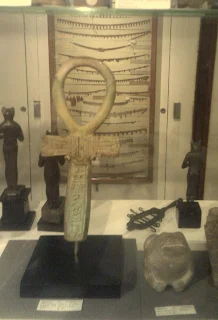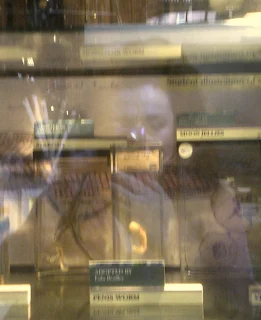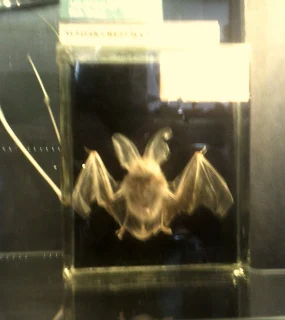The Petrie Museum of Egyptian Archaeology is part of University College London, and contains over 80,000 Egyptian and Sudanese artefacts. Established as a teaching resource in 1892, with the initial collection donated by novelist, journalist and traveller Amelia Edwards (1831-1892), professor and Egyptologist Sir William Matthews Flinders Petrie (1853-1942) conducted many excavations and sold his collection to University College in 1913. Initially a resource for students and academics, it has been open to the general public, in its current location, since 2018.
It was a baking hot July day when we ventured into central London, and this was the third- and final- museum which we visited in the vicinity that day. It wasn't easy to find, and we ended up taking an unscheduled tour through the university. Still, I ended up finding where the Slade School of Fine Art was situated (it's part of this building)- I once studied on an art foundation course, often heard it mentioned and was always curious as to where it was, exactly!
Here is the entrance point into the impressive courtyard.
It was a baking hot July day when we ventured into central London, and this was the third- and final- museum which we visited in the vicinity that day. It wasn't easy to find, and we ended up taking an unscheduled tour through the university. Still, I ended up finding where the Slade School of Fine Art was situated (it's part of this building)- I once studied on an art foundation course, often heard it mentioned and was always curious as to where it was, exactly!
Here is the entrance point into the impressive courtyard.
The museum is split into three galleries, with this part containing many of the small artefacts. It's a very traditional, working environment- no gimmicks, no light shows and just interesting items to see. I have to say, I loved it!
Wall of jewellery. There were lots of necklaces...
You could be forgiven for thinking you were in Claire's Accessories...😁
Old beads...
More beading and dangly bits...
These looks like bracelets. It's hard to read the writing (many of the accompanying cards are handwritten).
Bead making kit, including obsidian...
Clay remnants...
Tablets...
Copper mirror...
These are copper measuring implements...
This is labelled 'Limestone dwarf bearing a lamp'. I would have mistaken it for a fertility symbol, with the big breasts and belly depicting a pregnant lady...
He looks quite fierce and it looks like the inscription simply says 'striped limestone head'...
Sculptor's model of a female face...
I've always said that I like the way these birds did their eye make-up. I would...😉
This sphinx looks like he's trying to lift a meaty paw for you to shake...
Could this be a plaster depiction of a king?
I love this, and think she's some kind of container, as the one arm she has forms a handle, and the other may have broken off (as opposed to her supposed to being like this). I cannot read the inscription on the card, as light has bounced straight off it. Hot damn! Oh well, there's my excuse to go back sorted...
I seem to have taken a lot of amphorae photos...
I love the conjoined twin amphora...
...Even more! I like the cuteness of these, and they were mainly used for storing wine, so perhaps that's why they appeal to me...😉
These panels would have covered the face of a mummy...
They date from the time when Romans had control over Egypt- 30 BC till c.640 AD.
You can't have an Egyptian museum without the inclusion of a mummy or two. These were found in the second gallery, which actually consists mainly of pottery.
Of course, I had to find the shoe cabinet...😁
These photos are not excellent- I believe a flash was allowed, but they tend to offer up a reflective glare. I like these gloved-finger style of shoes...
Dean described this as him with a hangover...😁
The Egyptians believed that they had to do manual labour in the afterlife, just as they had to in real life. These shabtis are small figures which were placed in the tomb, to miraculously do this work for the deceased! They were mass-produced.
These mini-mummies look like they're shabtis...
Gilt-faced mask and a reflected Vain Old Tart.
I believe this (along with the conserved dress, below) were in the third section of the gallery, which is heading towards the stairwell and exit...
This conserved dress (which looks more like a top) was excavated at Tarkhan, one of the most important Egyptian cemeteries from the time the country was unified (it had previously been classed as Upper Egypt and Lower Egypt), around 3000 BC. The dress was found in a pile of linen taken from a c.2800 BC tomb. It's one of the oldest Egyptian dresses in the world, and a pattern and instructions for making a copy can be downloaded.
Ancient Egyptian linen dresses...
This bead net dress was excavated in 1923-24 and reconstructed in 1994-95. It may have been worn for dancing c.2400 BC, and was thought to fit a girl of 12 and be worn naked. The hem would have made the dress rattle as the girl jigged around!
This is a pot burial of an adult female...

This is a dancing girl cosmetic spoon (also known as a toilet spoon), and would have been used for storing or mixing perfumes or minerals for make-up. They were high status objects.
This is an 'ankh' (the hieroglyphic symbol for life) and is Sudanese.
These are rat traps...
What an enjoyable little place, and a delight for any scholar of Egyptology. I look forward to the day when I will be returning.
T.T.F.N.
The Miss Elaineous
XXXXX
XX
X






































































